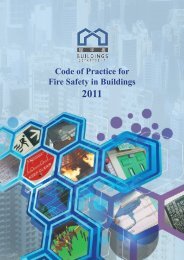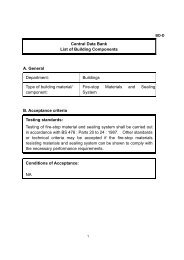Alkali-Aggregate Reaction in Reinforced Concrete Structures ...
Alkali-Aggregate Reaction in Reinforced Concrete Structures ...
Alkali-Aggregate Reaction in Reinforced Concrete Structures ...
Create successful ePaper yourself
Turn your PDF publications into a flip-book with our unique Google optimized e-Paper software.
Re-issued under new categorization <strong>in</strong> August 2009 as Practice Note for Authorized<br />
Persons, Registered Structural Eng<strong>in</strong>eers and Registered Geotechnical Eng<strong>in</strong>eers<br />
Build<strong>in</strong>gs Department<br />
Practice Note for Authorized Persons<br />
and Registered Structural Eng<strong>in</strong>eers<br />
<strong>Alkali</strong>-<strong>Aggregate</strong> <strong>Reaction</strong> <strong>in</strong> Re<strong>in</strong>forced <strong>Concrete</strong> <strong>Structures</strong><br />
Re<strong>in</strong>forced concrete structures can suffer from alkali-aggregate reaction (AAR).<br />
2. AAR is a chemical process <strong>in</strong> which alkalis, ma<strong>in</strong>ly from the cement, comb<strong>in</strong>e<br />
with certa<strong>in</strong> types of m<strong>in</strong>erals <strong>in</strong> the aggregate, when moisture is present. This reaction<br />
produces a gel that can absorb water and expand to cause crack<strong>in</strong>g and disruption of the<br />
concrete. The cracks accelerate the corrosion of the re<strong>in</strong>forcement <strong>in</strong> the concrete. Moreover,<br />
reduction <strong>in</strong> the compressive strength of the concrete reduces the strength of the concrete<br />
members.<br />
3. The follow<strong>in</strong>g factors are essential for AAR to occur <strong>in</strong> concrete:<br />
(a) There must be reactive m<strong>in</strong>erals present <strong>in</strong> the aggregate.<br />
(b) There must be sufficient alkali <strong>in</strong> the concrete to react with the<br />
aggregates.<br />
(c) There must be sufficient moisture available to enable the chemical<br />
reaction.<br />
APP-74<br />
4. A range of m<strong>in</strong>erals, <strong>in</strong>clud<strong>in</strong>g opal, tridymite, cristobalite, volcanic glasses,<br />
cryptocrystall<strong>in</strong>e to microcrystall<strong>in</strong>e quartz and poorly-crystall<strong>in</strong>e quartz, have been reported<br />
by overseas researchers as capable of caus<strong>in</strong>g AAR. The occurrence of AAR depends on both<br />
the type and percentage by mass of reactive m<strong>in</strong>erals present.<br />
5. The alkalis <strong>in</strong> the concrete come ma<strong>in</strong>ly from the cement. An effective means<br />
of reduc<strong>in</strong>g the risk of AAR <strong>in</strong>cludes proper control on the amount of cement used <strong>in</strong> the<br />
concrete mix, use of a low alkali cement, and appropriate use of cement replacement such as<br />
pulverised fuel ash (PFA).<br />
6. In 1992, a programme of studies on AAR was started by the Public Works<br />
Laboratories of the Hong Kong Government. These <strong>in</strong>cluded tests on concrete cores obta<strong>in</strong>ed<br />
from suspected structures, as well as <strong>in</strong>vestigations on the AAR potential of aggregates from a<br />
number of local quarries. The <strong>in</strong>vestigations are still on-go<strong>in</strong>g and the long-term tests may take<br />
a few years to complete. However, <strong>in</strong> view of the potential risks <strong>in</strong> the event of AAR<br />
occurr<strong>in</strong>g <strong>in</strong> structures and the long duration required for the experimental work, specification<br />
items (Appendix A) have been <strong>in</strong>troduced on all future Works Branch contracts.<br />
180<br />
/cont'd....
- 2 -<br />
7. To avoid the risk of AAR occurr<strong>in</strong>g, authorized persons / registered structural<br />
eng<strong>in</strong>eers should consider <strong>in</strong>corporat<strong>in</strong>g the specification clauses for the control of AAR <strong>in</strong><br />
concrete <strong>in</strong>to contracts for private development projects. In such cases, plans for approval<br />
should clearly <strong>in</strong>dicate that the reactive alkali of concrete expressed as the equivalent sodium<br />
oxide per cubic metre of concrete should not exceed 3.0 kg when determ<strong>in</strong>ed <strong>in</strong> accordance<br />
with the specification items given <strong>in</strong> Appendix A.<br />
8. The authorized person or registered structural eng<strong>in</strong>eer should ensure that the<br />
concrete mix complies with the limit on reactive alkali by requir<strong>in</strong>g the specification clauses to<br />
be complied with, unless he is <strong>in</strong> the op<strong>in</strong>ion that the concrete element will not be subject to<br />
<strong>in</strong>gress of moisture throughout its design life.<br />
Ref. : BD GP/BREG/C/7<br />
BD GR/CC/132<br />
First issued April 1995 (AD/SE)<br />
Index under : <strong>Concrete</strong><br />
<strong>Alkali</strong>-<strong>Aggregate</strong> <strong>Reaction</strong><br />
<strong>Aggregate</strong><br />
(Helen C P Lai YU)<br />
Build<strong>in</strong>g Authority
Control Measures<br />
Model Specification Clauses for<br />
for the Control of <strong>Alkali</strong>-<strong>Aggregate</strong> <strong>Reaction</strong> <strong>in</strong> <strong>Concrete</strong><br />
PNAP 180<br />
Appendix A<br />
APP-74<br />
1. Measures to control the occurrence of alkali-aggregate reaction (AAR) <strong>in</strong><br />
concrete shall be submitted to the authorized persons / registered structural eng<strong>in</strong>eers<br />
(AP/RSE) for approval. In the absence of alternative proposals, such control shall be achieved<br />
by limit<strong>in</strong>g the reactive alkali content of the concrete as described <strong>in</strong> clauses 2 to 4 below<br />
unless <strong>in</strong> the op<strong>in</strong>ion of the AP/RSE the concrete element will not be subjected to moisture<br />
<strong>in</strong>gress throughout its design life.<br />
Limit on Reactive <strong>Alkali</strong><br />
2. The reactive alkali of concrete expressed as the equivalent sodium oxide per<br />
cubic metre of concrete shall not exceed 3.0 kg.<br />
Equivalent Sodium Oxide (Na 2 O) Content<br />
3. The equivalent sodium oxide (Na 2 O) content of the concrete shall be<br />
determ<strong>in</strong>ed <strong>in</strong> accordance with the follow<strong>in</strong>g steps:<br />
(1) The equivalent Na2O shall be calculated by the expression<br />
Equivalent Na 2 O = A + B + C<br />
where A is the sum of the acid-soluble alkalis (expressed as<br />
equivalent Na 2 O) of cement, admixtures and water;<br />
B is equal to 1/6 the total alkalis of pulverised fuel ash<br />
(PFA) (expressed as equivalent Na 2 O); and<br />
C is equal to 0.76 times the chloride ion (Cl -) of the<br />
aggregate.<br />
(2) The acid-soluble alkali content of the cement shall be determ<strong>in</strong>ed <strong>in</strong><br />
accordance with BS 4550:Part 2:1970 (exclud<strong>in</strong>g amendment AMD<br />
7285, July 1992) and shall be taken as the average of the latest 25 daily<br />
determ<strong>in</strong>ations of equivalent sodium oxide plus twice the standard<br />
deviation of the results.<br />
(3) The acid-soluble alkali content of admixtures shall be determ<strong>in</strong>ed <strong>in</strong><br />
accordance with BS 1881:Part 124:1988.<br />
/cont'd....
- 2 -<br />
(4) The acid-soluble alkali content of water shall be determ<strong>in</strong>ed <strong>in</strong><br />
accordance with American Public Health Association (APHA) (17ed.<br />
1989) Sections 3500-K and 3500-Na.<br />
(5) The total alkali content of the PFA shall be determ<strong>in</strong>ed <strong>in</strong> accordance<br />
with BS 4550:Part 2:1970 (exclud<strong>in</strong>g amendment AMD 7285, July<br />
1992) and shall be taken as the average of 25 weekly determ<strong>in</strong>ations<br />
plus twice the standard deviation of the results.<br />
(6) The equivalent sodium oxide content of the coarse and f<strong>in</strong>e aggregates<br />
shall be calculated from the quantity of chloride ion present which shall<br />
be measured <strong>in</strong> accordance with BS 812:Part 4:1976.<br />
Test Certificates and Calculations<br />
4. The follow<strong>in</strong>g particulars of the concrete mix should be submitted by the<br />
concrete supplier to the AP/RSE:<br />
(1) HOKLAS-endorsed test certificates not older than six months giv<strong>in</strong>g the<br />
results of tests required <strong>in</strong> clauses 3 (2) to (6);<br />
(2) Calculation of the reactive alkali of the proposed mix; and<br />
(3) New HOKLAS-endorsed test certificates giv<strong>in</strong>g the results of tests<br />
required <strong>in</strong> clauses 3 (2) to (6) to be submitted at quarterly <strong>in</strong>tervals<br />
together with any necessary further calculations to demonstrate that the<br />
mix cont<strong>in</strong>ues to comply with the limit on reactive alkali.<br />
Ref: PNAP 180<br />
First issued April 1995
















